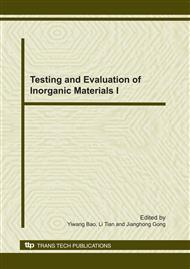p.18
p.22
p.25
p.29
p.32
p.37
p.41
p.45
p.49
ZnFe2O4 Modified by Fe(NO3)3 for the Synthesis of Ionic Ferrofluids
Abstract:
Weak magnetic ZnFe2O4 nanoparticles were prepared by coprecipitation and treated with different concentrations of Fe(NO3)3 solution. Untreated and treated particles were studied using a vibrating sample magnetometer, transmission electron microscope, by X-ray diffraction, X-ray energy dispersive spectroscopy and X photoelectron spectroscopy. The results showed that, after treatment, the ZnFe2O4/γ-Fe2O3 forms disphase nanoparticles, with enlarged size, enhanced magnetic properties and with a surface parceled with Fe(NO3)3. The size of the particles and their magnetic properties are related to the concentration of the treatment solution. The particle size and magnetic properties could be controlled by controlling the concentration of treating solution, therefore nanoparticles can be more widely used.
Info:
Periodical:
Pages:
32-36
Citation:
Online since:
December 2010
Authors:
Keywords:
Price:
Сopyright:
© 2011 Trans Tech Publications Ltd. All Rights Reserved
Share:
Citation:


